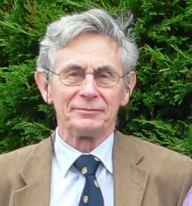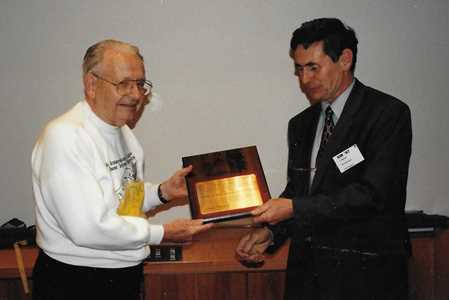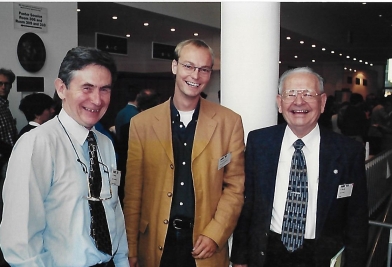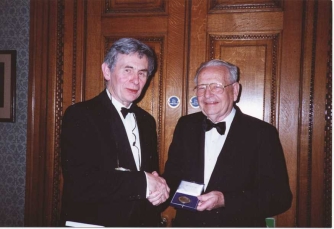My memories of Karl

Contribution from
Tony Davies, NNIRC.co.uk
I’m sure that we all remember our first meeting with Karl. I certainly do! It was at the first IDRC meeting at Wilson College, Chambersburg, in 1982. This was my first trip to USA and my first experience of “jet lag” and I was not sleeping well. On the first day of the conference I woke early and went for a run and looked forward to meeting Karl Norris. I didn’t get a chance; he was always surrounded by other delegates, with the same intention. I woke early on the second day and started out on my run but after a few minutes I caught-up with Karl on his morning walk ALONE!
I instantly decided that I wanted to walk and we had a lovely chat for about twenty minutes. When I returned to my room I realised that he seemed more interested to learn what I was hoping to do with NIR than discussing what he had done!
I made several visits to Karl’s lab and in the first few years he was developing his NIR method for measuring human body fat. He called me “our lean standard” (which greatly pleased me!). On one visit he said “We are giving a demonstration of the method to the Secretary of Agriculture’s Advisory Committee. Would you like to come along?” “Yes please “. The Secretary’s committee was “PC” at work. Three women and two men one of them black. Karl described the instrument and demonstrated on himself and then asked them “Would one of you like to try it?” After a moment’s pause the black man stepped forward. “Yes, sure”, rolling up his sleeve. Karl was clearly embarrassed. “I’m sorry but it doesn’t work with black skin … but we are working on it”! Another pause and then all of the other four members step forward saying “Try me”. Karl selected one of the ladies and all was well. The lean standard kept quiet!
Karl loved to surprise people. I once opened a letter from him and found he had sent me his first NIR spectrum! It was of a newly laid chicken’s egg; he was trying to find a measurement for “freshness”. It had taken 10 minutes to make the individual measurements of each point in the spectrum, at 10nm intervals, by carefully adjusting the spectrometer. There was a set of spectra taken at 20-minute intervals, which clearly showed a change with time. For a short while Karl thought that he had made a discovery but after further thought he realised that what he was recording was the egg drying out in the first hour or so of being laid. He had put them away in a file and they had been in his filing cabinet for 40 years! He thought I might be interested. It was the first “scoop” for NIR News!
In 1983 my group at the Food Research Institute became interested in work done by Tom Fearn on the “best-pair” of correlating wavelengths for determination of an analyte in a particular sample type. If the spectrometer measures absorption for every second wavelength over the range 700 to 2400 nm then there will be 244,650 possible pairs (which even in the 1980’s could be computed quite rapidly by a micro computer) but this is only the beginning of the search. We decided on a colour-graphic approach which allowed an operator to select promising areas for additional computation. I presented our method ("CROME") at a meeting in Washington in 1984 but I didn’t think Karl was interested or impressed.
I was able to visit Karl’s lab in August1984 (on the way to Chambersburg for the second IDRC) and after Karl had discussed some of his work he said “we have something to show you. We thought your colour-graphic method was interesting so here is our version” and he showed me something similar to CROME but then he said “we have a new computer so we thought we would see what it could do”. He then showed a second program which computed areas of interest in real time! I was amazed, our programs required two over-night runs to produce our results (close to 30 hours of computing!).

I once did managed to surprise him. At the 1997 ICNIRS conference in Essen, Germany we surprised Karl by making him the first Fellow of Near Infrared Spectroscopy and as well as the plaque I presented him with a Special volume of JNIRS in his honour, which we had managed to produce with out his knowledge!.
Presenting Karl with the Fellow of NIRS plaque in 1997.
Some time before NIR-97 I received a letter from a student in Germany, Thorsen Burger, who told me that he was trying to understand diffuse reflection and wanted to get in touch with Karl. I told him "if you come to the NIR conference in Essen I will introduce you to him". He came, he found me and I introduced them. It was no surprise to me that they got on well and Thorsen acknowledged Karl in a resulting publication.

Thorsen meets Karl
In 1998 the Analytical Division of the Royal Society of Chemistry announced a new prize with an unusual specification that the nomination should be for the developer or co-developer of a significant advance in analytical chemistry, the recipient could be of any nationality and need not be a chemist. The prize to be called the Sir George Stokes Award and the recipient will receive a medal. (It is often referred to as the Sir George Stokes Medal). When I read about it I thought that Karl should be the obvious choice for the first award in 1999 but I was disappointed that it went to Alec Jefferies, for DNA profiling (a good choice but I thought the first award ought to have gone to a non-British subject). I was successful in my bid for Karl to get the second award in 2001
Karl came to London for the award ceremony and I didn’t want to miss the opportunity for Karl to give a lecture to the NIR community. With help from Tom Fearn, I organised a meeting at University College London and Karl gave two lectures while Tom and I completed the programme. When we finished Karl said that he was a "little tired"! I thought, “I hope he will be OK for tomorrow”. I should not have asked him to do so much! But he was fine and the audience were obviously

Karl with the Sir George Stokes medal.
impressed; particularly by him telling them that some of George Stokes’ more obscure mathematics had been used in his most recent publication with Don and Kevin Dahm!
Karl was genius but even as important, he was a very lovely man. He changed many people’s lives when he converted them to NIR but he changed mine twice!
At the 1986 international NIR meeting in Budapest there was not much support for the Russian proposal for the formation of an international body. It was suggested that a sub-committee should be formed and in addition to the expected names Karl suggested that I should be the UK representative. The sub-committee didn’t like the Russian “top-down” proposal but came up with a “bottom-up” idea which was named ICNIRS. The result was that I organised the first ICNIRS conference in 1987, became Treasurer and Secretary (briefly) and later chairman, started NIR news and JNIRS! All because Karl had “elected” me to the sub-committee when I was a very much a new boy in the NIR field !
I am doubly grateful to him and his wonderfully beneficial effect on my life.
Tony Davies




